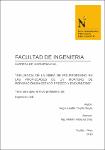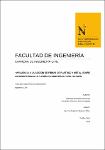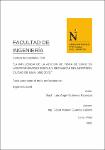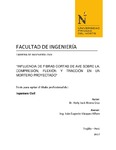Mostrar el registro sencillo del ítem
Influencia de la fibra de polipropileno en las propiedades de un mortero de reparación en estado fresco y endurecido
| dc.contributor.advisor | Vásquez Díaz, Alberto | |
| dc.contributor.author | Trujillo Rojas, Angie Lisette | |
| dc.date.accessioned | 2018-08-22T20:27:53Z | |
| dc.date.available | 2018-08-22T20:27:53Z | |
| dc.date.issued | 2018-06-18 | |
| dc.identifier.citation | Trujillo, A. L. (2018). Influencia de la fibra de polipropileno en las propiedades de un mortero de reparación en estado fresco y endurecido [Tesis de licenciatura, Universidad Privada del Norte]. Repositorio de la Universidad Privada del Norte. Recuperado de https://hdl.handle.net/11537/13749 | es_PE |
| dc.identifier.other | 624.1834 TRUJ 2018 | es_PE |
| dc.identifier.uri | https://hdl.handle.net/11537/13749 | |
| dc.description.abstract | El presente trabajo tiene como objetivo estudiar la influencia de la incorporación de la fibra de polipropileno en un mortero para ser utilizado con fines de reparación estructural de superficies horizontales, tales como pisos o lozas aligeradas. En la investigación se realizaron ensayos comparativos entre un mortero patrón, sin adición de fibras y morteros con distintas dosis de fibra adicionada. La fibra adicionada que se empleó fue la Sika-Cem Fiber 1 en las dosis de 300 g., 400 g. y 900 g. de fibra por metro cúbico de mortero. Obteniéndose un total de cuatro diseños de mezcla, para una resistencia a la compresión a los 28 días. Los ensayos realizados al mortero en estado fresco fueron el asentamiento y la temperatura, dando mayor énfasis a la evaluación de fisuras por contracción plástica, la cual se desarrolló tomando como referencia los lineamientos expuestos en la norma ASTM C1579-13 “Standar test method for evaluating plastic shrinkage cracking of restrained fiber reinforced concrete (Using a steel form insert)”. En estado endurecido al mortero se le realizó los ensayos de compresión y flexión de acuerdo a las normas, ASTM C109 y ASTM C293, respectivamente. Del análisis de los resultados de la presente investigación se pudo observar que a mayor cantidad de fibra adicionada en el mortero fresco, fue menor la fisuración y retrasó brevemente la aparición de la primera fisura, con respecto al mortero patrón. En el mortero endurecido, se determinó que la adición de fibras de polipropileno no se modificó en forma significativa por la inclusión de fibras. Finalmente, se concluyó que con el uso de la fibra se obtuvo mejores resultados en el mortero en estado fresco, debido a su buen comportamiento frente a la fisuración, y el mortero en estado endurecido, por el ligero incremento en su resistencia a la flexión. Teniendo además una óptima relación costo-beneficio. | es_PE |
| dc.description.abstract | The objective of this work is to study the influence of the incorporation of polypropylene fiber in mortar to be used for structural repair purposes such as lightened slabs. Comparative trials were conducted in the research between a mortar pattern, without the addition of fibres and mortars with different doses of added fiber. Added fiber that was used was the Sika-Cem Fiber 1 in doses of 300, 400 and 900 g. of fiber per cubic meter of mortar. Resulting in a total of four mix designs, for resistance to compression of to 28 days. Trials to mortar in fresh were the settlement and temperature, giving greater emphasis to the evaluation of cracks by plastic shrinkage, which was developed under controlled environmental conditions, based on the guidelines exposed in the standard ASTM C1579- 13 “Standar test method for evaluating plastic shrinkage cracking of restrained fiber reinforced concrete (Using a steel form insert)”. In hardened mortar State was carried out trials of compression and flexion in accordance ASTM C109 and ASTM C293, respectively. The analysis of the results of this research that a greater amount of added fiber mortar settlement is less, less is cracking and briefly delays the onset of the first crack, with respect to the mortar pattern could be observed. Hardened mortar, it was determined that the addition of polypropylene fibers increases slightly (not significant) resistance to compression, however not overcame the resistance of mortar pattern. With respect to the resistance to bending, this was indirectly proportional behavior to the addition of fibres. Greater addition of fibers, the resistance decreases and vice versa. Finally, it was concluded that with the use fiber, better results are obtained both in the fresh mortar, due to its good behavior against cracking, and in the hardened state, with a slight increase in its resistance to bending. Having an optimal cost-benefit ratio. | es_PE |
| dc.description.uri | Tesis | es_PE |
| dc.format | application/pdf | es_PE |
| dc.language.iso | spa | es_PE |
| dc.publisher | Universidad Privada del Norte | es_PE |
| dc.rights | info:eu-repo/semantics/openAccess | es_PE |
| dc.rights | Atribución-NoComercial-CompartirIgual 3.0 Estados Unidos de América | es_PE |
| dc.rights.uri | https://creativecommons.org/licenses/by-nc-sa/3.0/us/ | * |
| dc.source | Universidad Privada del Norte | es_PE |
| dc.source | Repositorio Institucional - UPN | es_PE |
| dc.subject | Concreto | es_PE |
| dc.subject | Materiales de construcción | es_PE |
| dc.subject | Ingeniería civil | es_PE |
| dc.title | Influencia de la fibra de polipropileno en las propiedades de un mortero de reparación en estado fresco y endurecido | es_PE |
| dc.type | info:eu-repo/semantics/bachelorThesis | es_PE |
| thesis.degree.grantor | Universidad Privada del Norte. Facultad de Ingeniería | es_PE |
| thesis.degree.level | Título Profesional | es_PE |
| thesis.degree.discipline | Ingeniería Civil | es_PE |
| thesis.degree.name | Ingeniero Civil | es_PE |
| dc.publisher.country | PE | es_PE |
| dc.subject.ocde | https://purl.org/pe-repo/ocde/ford#2.01.01 | es_PE |
| thesis.degree.program | Pregrado | es_PE |
| dc.description.sede | Trujillo San Isidro | es_PE |
| renati.advisor.dni | 40385695 | |
| renati.advisor.orcid | https://orcid.org/0000-0001-9018-5763 | es_PE |
| renati.author.dni | 74653318 | |
| renati.discipline | 732016 | es_PE |
| renati.juror | Azañedo Medina, Wiston | |
| renati.juror | Avalos, Ricardo | |
| renati.juror | Sagástegui, Germán | |
| renati.level | https://purl.org/pe-repo/renati/level#tituloProfesional | es_PE |
| renati.type | http://purl.org/pe-repo/renati/type#tesis | es_PE |
Ficheros en el ítem
Este ítem aparece en la(s) siguiente(s) colección(ones)
-
Tesis [1444]








